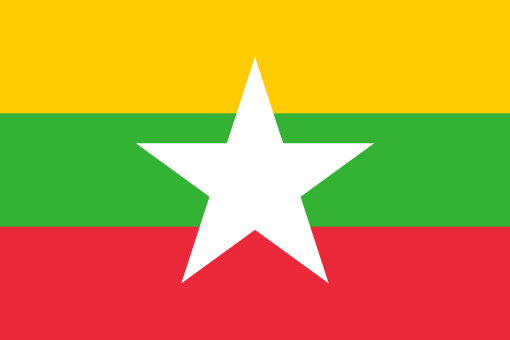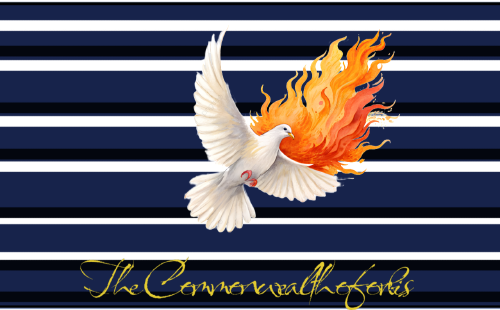| National Factbook |
| Flag: |

|
| Nation Name: |
Myanmar |
| Leader Name: |
Nay Lin Aung |
| Currency: |

Kyat |
| National Animal: |

Lion |
| History: |
The Republic of the Union of Myanmar was founded on 28 November 2111 (Orbis Date) during one of the darkest and most unstable periods in the nation's history. Years of political corruption, weak civilian leadership, and foreign-backed insurgencies had pushed the country to the brink of collapse. Ethnic conflicts escalated, the central government fractured, and lawlessness spread across the land.
Amid this chaos, the people turned to the only institution that had not yet crumbled — the Tatmadaw, Myanmar’s armed forces. At the forefront stood Senior General Nay Lin Aung, a highly disciplined, charismatic, and loyal commander known for his strong leadership and deep sense of national duty.
With the backing of loyal military units and overwhelming public support, Senior General Nay Lin Aung launched a nationwide operation to restore order, secure national unity, and defeat rebel forces. The armed forces quickly reasserted control, safeguarded Buddhist institutions, protected key infrastructure, and drove out insurgents threatening national sovereignty.
Under Nay Lin Aung’s leadership, the State Administration Council was formed to act as a caretaker government. The General pledged not to cling to power indefinitely. Drawing inspiration from Senior General Saw Maung — who also took over Myanmar in crisis and promised a return to democracy — Nay Lin Aung committed to holding multi-party elections within the next Orbis year (roughly one real-life month). A new, stable, and secure republic was born.
Though Myanmar remains under a transitional military administration, the people see Senior General Nay Lin Aung not as a dictator, but as a guardian of the state. His leadership not only saved the nation from disintegration but laid the foundation for a future built on peace, order, and eventual democratic transition.
The Republic of the Union of Myanmar now stands as a symbol of resilience — forged in conflict, unified by strength, and led by a generation that refused to let the country fall. |
| Geography |
| Continent: |
Asia |
| Land Area: |
9,656.04 sq. km |
| Terrain: |
Myanmar features a diverse and dramatic terrain shaped by its location between the Himalayan foothills and Southeast Asia's tropical plains. The country spans a wide range of geographic features, which strongly influence its climate, agriculture, and ethnic diversity.
1. Mountain Ranges:
Eastern Highlands: The Shan Plateau dominates eastern Myanmar, with rolling hills and rugged mountains. It is home to many ethnic groups, such as the Shan and Pa-O.
Western Ranges: The Rakhine Yoma and Chin Hills form natural barriers along the western frontier, extending into India and Bangladesh.
Northern Highlands: The Hkakabo Razi region in Kachin State is Myanmar’s highest point (5,881 m / 19,295 ft), part of the eastern Himalayan range.
2. Central Lowlands:
The Dry Zone lies in the central region between the Shan Plateau and western hills. It includes cities like Mandalay and Nay Pyi Taw. This area is arid but agriculturally important due to irrigation projects and the Ayeyarwady River.
3. River Valleys and Plains:
The Ayeyarwady River is Myanmar’s lifeline, flowing from north to south and forming a fertile delta in the south. It supports rice cultivation, transport, and fishing.
Other major rivers include the Chindwin, Thanlwin (Salween), and Sittaung.
4. Coastal Regions:
The country has two main coastlines:
Bay of Bengal (west) with the Rakhine Coast
Andaman Sea (south) with the Tanintharyi Coast
These regions feature mangrove forests, islands, and deep-sea harbors like Dawei and Kyaukphyu.
5. Forests and Biodiversity:
Myanmar contains vast tropical and subtropical forests, particularly in Kachin, Sagaing, and Tanintharyi.
The terrain supports rich biodiversity, including elephants, tigers, and rare orchids.
Summary: Myanmar’s terrain is a blend of high mountains, dry plains, fertile river valleys, and long coastlines. This geographical variety contributes to the nation's cultural richness, strategic importance, and economic potential—especially in agriculture, energy, and trade.
|
| Highest Peak: |
Mount Hkakabo Razi, 5,881 meters |
| Lowest Valley: |
Ayeyarwady Delta, 2 meters |
| Climate: |
Myanmar has a tropical monsoon climate, influenced by the Indian Ocean and the Southeast Asian monsoon system. The country experiences three distinct seasons, with regional variations due to its diverse terrain.
1. Three Main Seasons:
Hot Season (March to May):
Temperatures can rise above 40°C (104°F) in the central Dry Zone.
Coastal and mountainous areas are comparatively cooler.
The season is dry, with intense heat before the monsoon arrives.
Rainy Season / Monsoon (June to October):
Brought by the southwest monsoon winds from the Bay of Bengal.
Heavy rainfall, especially in coastal and hilly regions like Rakhine, Tanintharyi, and Kachin.
The Ayeyarwady Delta often faces flooding during peak months.
Central Myanmar (Dry Zone) receives less rain, remaining semi-arid.
Cool Season (November to February):
Pleasant weather across most of the country.
Temperatures range between 15°C to 25°C (59°F to 77°F) in lowlands.
In highland regions like Shan and Chin states, temperatures can drop below 5°C (41°F) at night.
2. Regional Climate Differences:
Central Myanmar (Dry Zone):
Semi-arid climate with low annual rainfall (500–1,000 mm).
Hot and dry for most of the year.
Coastal Areas (Rakhine, Mon, Tanintharyi):
Receive over 4,000–5,000 mm of rainfall annually.
Humid and prone to tropical storms during monsoon season.
Northern Highlands (Kachin, Chin):
Cooler year-round with misty mountains.
Snowfall may occasionally occur in the far north near Hkakabo Razi.
3. Natural Climate Hazards:
Cyclones: Occur mainly in the Bay of Bengal between April and November. Notable storms include Cyclone Nargis (2008).
Floods: Common in the delta and riverine regions during monsoon.
Droughts: Affect central Myanmar due to limited rainfall.
|
| People & Society |
| Population: |
561,068 people |
| Demonym: |
Burmese |
| Demonym Plural: |
Burmese |
| Ethnic Groups: |
Bamar (Burmese) - 70.0%
Sham - 10.0%
Karen - 8.0% |
| Languages: |
Burmese - 88.0%
Shan - 6.0%
Karen - 5.0% |
| Religions: |
Theravāda Buddhism - 86.0%
Islan - 10.0%
Christian - 4.0% |
| Health |
| Life Expectancy: |
90 years |
| Obesity: |
6% |
| Alcohol Users: |
0.9% |
| Tobacco Users: |
44.4% |
| Cannabis Users: |
85% |
| Hard Drug Users: |
0.2% |
| Economy |
| Description: |
Economic System:
State-Guided Mixed Economy
(Strategic sectors under military-civilian partnership, private enterprise allowed under national policy guidelines)
---
Overview:
After the national crisis that led to the fall of the previous government, the economy of the Republic of the Union of Myanmar was in ruins — marked by inflation, corruption, collapsed infrastructure, and a destroyed industrial base. Under the direction of Senior General Nay Lin Aung, the military government launched an aggressive and pragmatic economic revival plan, inspired by national strength and long-term self-reliance.
Today, Myanmar is undergoing a state-guided economic recovery, focusing on essential industries, food security, and strategic infrastructure, while encouraging controlled private sector participation and international trade partnerships.
---
Key Sectors:
Agriculture & Fisheries (38% of GDP)
The backbone of the economy. Government-supported rice, oilseed, tea, and seafood exports are rising under land reform and Tatmadaw-supported irrigation projects.
Energy & Natural Resources (24% of GDP)
Myanmar's rich gas, jade, and rare earth deposits are now regulated through state-owned enterprises (SOEs). Corrupt licenses were revoked, and military engineers oversee clean, accountable extraction.
Defense & Infrastructure Development (18% of GDP)
Massive public investment in roads, railways, ports, and telecommunications is underway, overseen by the Ministry of Defense and Civil Development. Strategic zones have been created for industrial growth and export production.
Manufacturing & Industry (12% of GDP)
Textiles, food processing, and basic machinery are being revived. Domestic weapons and military equipment production is also prioritized under national security doctrine.
Tourism, Culture, and Domestic Trade (8% of GDP)
With peace restored, religious tourism and cultural heritage projects are emerging. Domestic trade is protected and regulated by the Ministry of Commerce.
---
National Development Strategy:
✔️ The Three Pillars of Economic Recovery
1. National Security First – Economic development must never weaken sovereignty.
2. Self-Sufficiency – Focus on domestic production, especially food and energy.
3. Strategic Partnerships – Trade only with nations that respect Myanmar’s sovereignty.
✔️ Flagship Projects
The "Golden Myanmar Railway", connecting north to south for trade and troop mobility.
Tatmadaw Industrial Parks, encouraging private investment in military-protected zones.
"One Township, One Industry" policy to promote local self-reliance.
---
Currency:
Myanmar Kyat (MMK)
Exchange rate fixed under central authority, inflation strictly controlled.
---
Foreign Trade:
Main Export Partners: Friendly Orbis nations, Commonwealth of Orbis allies
Main Exports: Natural gas, rice, jade, rare earth minerals, seafood
Main Imports: Machinery, fuel, medical supplies, high-tech systems
Note: Trade with hostile or communist-backed nations is prohibited under national law.
---
Economic Outlook:
Under the firm but visionary guidance of Senior General Nay Lin Aung, Myanmar’s economy is moving from post-crisis recovery to disciplined growth. The people are motivated, industries are returning, and the dream of a strong, self-reliant, and prosperous Union is becoming a reality.
“Discipline, Growth, Sovereignty” — The Myanmar Economic Path. |
| Average Yearly Income: |
$222.37 |
| Gross Domestic Product (GDP): |
$2,029,334,666.00 |
| GDP per Capita: |
$3,616.91 |
| Gross National Income (GNI): |
$1,684,270,965.00 |
| Industries: |
The industrial sector of Myanmar is undergoing a structured revival under the command of Senior General Nay Lin Aung, who has prioritized national strength, strategic production, and economic independence. A mixed model of military oversight and private participation allows the economy to grow while protecting national interests.
---
1. Defense Industry
Controlled by: Ministry of Defense / Tatmadaw Engineering Corps
Focus: Small arms, ammunition, armored vehicles, drones, uniforms, and basic defense systems
Goal: Ensure military self-sufficiency and reduce dependency on foreign arms
> "National survival requires national production." — Senior General Nay Lin Aung
---
2. Energy and Mining
Controlled by: Ministry of Energy and Natural Resources
Key Resources: Natural gas, oil, jade, copper, gold, rare earths
Special Zones: Military-secured resource corridors
Exports: Gas and minerals to friendly nations in Orbis
> The jade and energy sectors fund both national development and defense.
---
3. Agriculture & Agro-Industry
Products: Rice, tea, beans, fish, poultry, palm oil
Sub-sectors: Fertilizer production, food processing, seed and irrigation technology
Projects: Tatmadaw-led irrigation and farming mechanization campaigns
Export Brands: "Golden Myanmar Rice", "Unity Tea Leaves"
---
4. Manufacturing and Light Industry
Key Products: Textiles, shoes, processed foods, motorcycles, electronics assembly
Special Focus: “One Township, One Industry” model to grow rural factories
Support: Tax breaks, military security for domestic investors
---
5. Construction & Infrastructure
Led by: Ministry of National Development and Military Engineering Corps
Activities: Highways, bridges, ports, airports, dams, military bases
Major Project: “Golden Myanmar Railway” connecting north to south
> Infrastructure is viewed as both economic and strategic—built to serve both people and defense.
---
6. Industrial Parks & Special Economic Zones (SEZs)
Example Zones: Naypyidaw Defense Industrial Complex, Yangon Tech SEZ, Mandalay Agro Park
Features: Tax incentives, military protection, export-ready facilities
Partners: Trusted Orbis allies only
---
7. Tourism and Cultural Industries
Revived Sites: Shwedagon Pagoda, Mandalay Palace, Inle Lake
New Projects: "Patriotic Tours" showcasing Tatmadaw achievements
Cultural Products: Handicrafts, traditional dress, royal heritage souvenirs
---
8. Technology and Telecommunications
Controlled by: Ministry of Information and Technology
Key Areas: Secure communications, national internet service, surveillance systems
Military Role: Cybersecurity and state media modernization
---
Industrial Strategy Goals (Next Orbis Year):
✅ Increase defense production capacity by 40%
✅ Launch 3 new SEZs under army supervision
✅ Export surplus rice, gas, and jade to Orbis allies
✅ Employ 1 million citizens in state-protected industrial jobs
✅ Open Myanmar’s first military-built electronics plant |
| Military |
| History: |
(Tatmadaw – Armed Forces of the Republic)
---
Supreme Commander:
👑 Senior General Nay Lin Aung
Commander-in-Chief of Defence Services, Savior of the Nation
---
Overview:
The Tatmadaw is the protector of the state, people, and Constitution. Following the 2111 crisis that nearly tore the country apart, it was the leadership and discipline of Senior General Nay Lin Aung that restructured and revived the armed forces into a professional, modernized, and people-centered institution. Today, the Tatmadaw not only guards the borders and maintains internal security—it also leads national recovery, development, and stability.
---
⚔️ Branches of the Tatmadaw
1. Myanmar Army (Tatmadaw Kyi)
Commander-in-Chief: Vice-Senior General Nyan Lin Htet
Role: Ground combat, border security, disaster relief, and counter-insurgency
Major Units:
Light Infantry Divisions (LID)
Special Operations Command
Armored Brigades
Artillery Corps
Elite Force: 88th Strategic Command (Special Forces)
---
2. Myanmar Navy (Tatmadaw Yay)
Commander-in-Chief: Admiral Shine Min Htet
Role: Maritime defense, sea lane security, riverine operations
Fleets:
Bay of Bengal Command
Andaman Coastal Squadron
Naval Infantry: Amphibious assault troops and SEAL-style commandos
Assets: Corvette-class ships, patrol boats, drones, missile launch platforms
---
3. Myanmar Air Force (Tatmadaw Lay)
Commander-in-Chief: General Han Min Lwin
Role: Air superiority, ground attack, troop mobility, medevac and ISR (Intelligence/Surveillance/Recon)
Key Aircraft:
Multirole fighters (comparable to JF-17s, MiG-29s)
Transport aircraft (C-130 equivalent, Y-12)
Helicopters (Mi-35, transport choppers)
UAV squadrons (armed and reconnaissance)
---
4. Strategic Command (Tri-Service)
Chief of General Staff: General Shin Khant Kyaw
Duties: Unified coordination between army, navy, air force and special commands
Divisions:
Cyber Warfare Command
Strategic Missile Development Unit
Military Intelligence (MI) – led by General Htet Nay Lin
Homeland Defense Command
---
🪖 Manpower and National Defense Readiness
Active Duty Troops: 500,000+
Reserve Forces: 1.2 million trained reservists
People's Militia: Civilians trained by the army to defend local areas
Military Academies:
Defence Services Academy (DSA)
Air Force Academy
Naval College
National Defence University (NDU)
---
🏭 Military Industry & Defense Projects
State-Owned Arms Factories: Producing rifles, APCs, rockets, uniforms
Defense Industrial Zones: Protected by military; export-ready
Future Projects:
Indigenous drone fleet
Missile defense system
Joint-venture armored vehicle programs
---
🛡️ Doctrine & Core Values
> "Discipline, Loyalty, Sovereignty."
The Tatmadaw operates under the doctrine of total defense—protecting Myanmar’s independence, culture, and constitution. It follows a strict chain of command and military code of honor passed down from generations of warriors, now modernized by Senior General Nay Lin Aung’s leadership.
---
🌍 International Cooperation
Alliances: Strategic defense pacts with Orbis allies
Peacekeeping: Participation in Orbis humanitarian missions
Defense Exercises: Regular joint drills with trusted friendly nations
Non-Aligned: No foreign bases on Myanmar soil; full sovereignty maintained
|
| Soldiers: |
41,643 |
| Tanks: |
2,750 |
| Aircraft: |
150 |
| Ships: |
30 |
| Missiles: |
0 |
| Nuclear Weapons: |
0 |
| Last Updated: 06/20/2025 04:15 pm |



















